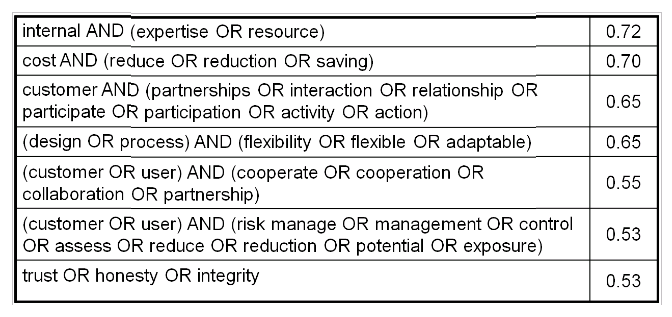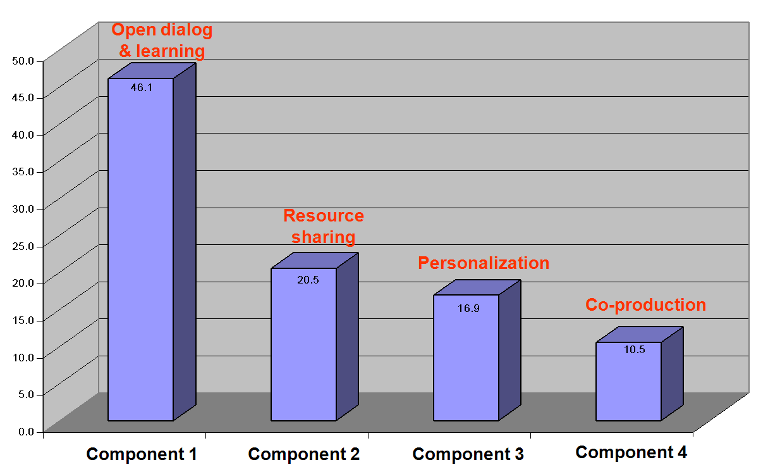"Co-creation is an active, creative and social process, based on collaboration between producers and users, that is initiated by the firm to generate value for customers."
Co-creation: New pathways to value
Value co-creation is an emerging innovation, marketing and business paradigm describing how customers and users are seen as active participants in the design of personalized products, services and experiences. Often this participation is organised via the Internet to enable the opportunity for customers to integrate their knowledge, experience and skills into existing, modified or entirely new market offerings reflecting their personal preferences, needs and contexts. There is a growing body of literature dedicated to the discussion of value co-creation frameworks, mechanisms and processes. However, these typically focus on the study, discussion and analysis of a small number of cases using deep, ethnographic description of their practices aiming at conceptualization and categorization of the different types of interactions between end users, the firm and the value network. Although useful, such an approach misses the advantages of an empirically driven quantitative approach that benefits from larger size samples and is more appropriate for theory building through the development and testing of hypotheses. It is important, therefore, to seek the development of a research methodology that combines the benefits of both qualitative and quantitative research approaches for studying the nature of value co-creation.
The article provides a first attempt to identify the main research steps of such a methodology. It provides some preliminary results on the key components of value co-creation between firms and end customers based on the application of web search and Principal Component Analysis (PCA) techniques. The analysis of these preliminary results is then used as an opportunity to identify a number of research questions to be addressed in future research. The emerging research questions follow the inner logic of the value co-creation phenomenon as well as the nature of the results reported in this article. The specific nature of the results was found to be suitable for the application of small-N techniques such as the Qualitative Comparative Analysis (QCA) technique which combines the advantages of both qualitative and quantitative techniques. One of the main contributions of this article is to suggest and explore the possibility for using the QCA technique in future research on value co-creation.
Research Objective, Strategy and Method
Our research has two main objectives. First, to use website content and exploratory factor analysis techniques to provide a categorization of the value co-creation approaches employed by a large sample of companies. Second, to identify some key research questions in association with a methodology combining the benefits of both quantitative and qualitative approaches for a deeper study of the components of value co-creation.
An extensive study of the literature on value co-creation, complemented by the examination of a number of specific websites, was used to develop a list of keyword combinations representing the largest possible spectrum of the dimensions associated with value co-creation. The resulting list of keywords were the terms used in a web search of a large sample of publicly available websites to gather data representative of the presence of the various co-creation dimensions. The data enabled the use of PCA in identifying a set of underlying factors that characterize the specific emerging types of value co-creation present in the sample of firms. This approach builds on previous works using keyword analysis and web data mining techniques. It is based on two main findings: i) the majority of small and medium-size firms use their web pages to articulate their commercialization strategies; and ii) firms involved in value co-creation activities use the Internet as an important channel for value co-creation.
The unit of analysis is the website of an organization actively engaged in value co-creation. The sample included 287 companies. Each company in the sample carried out co-creation activities and its website contained between 50 and 1,550,000 sub-pages. Table 1 provides a breakdown of the sample organizations into three types: open source software (OSS) companies, organizations associated with the business ecosystem driven by the Eclipse Foundation, and others.
Table 1: Breakdown of Sample Organizations

The keywords list consisted of 29 combinations of words. Table 2 shows a breakdown of one specific keyword combination with an example of the context from which each word was derived.
Table 2: Example of a Keyword Set Structure, Source and Context
The Keyword Search Tool provided the counts of hits for each search term at each website normalized by the total number of web pages present at the website. PCA was selected as the factor extraction method for factor analysis since it provided the cleanest component loading table.
Research Results
Tables 3 through 6 show the resulting four extracted components with their associated keywords and principal component loadings. Each of the four factors describes a component of co-creation.
Table 3: Factor 1
Table 4: Factor 2
Table 5: Factor 3
Table 6: Factor 4
Factor Interpretation
Factor 1 was labelled "Community Forum for Open Dialog and Learning." It is an indicator of the presence of a community forum designed to engage customers in an open dialog. It includes networking, information sharing and learning activities with the organization, other customers or other members of the value network.
Factor 2 was labelled "Partnerships for Resource Sharing." It describes the use of partnerships for user to access company expertise and resources, participate in the creation of adaptable designs and processes. Partnerships are based on trust, integrity and risk management.
Factor 3 was labelled "Personalization via Options and Modularity." It focuses on the personalization of offers that provide choices and options.
Factor 4 was labelled "Co-production" and used to describe the co-production of offers by user involvement in manufacturing, assembly and final beta trial activities requiring disclosure and sharing of intellectual property.
Value Co-creation Approaches
The four value co-creation components identified can be thought of in two ways: i) components of different co-creation approaches; and ii) as stages of a vaule co-creation maturity model with Factors 1, 2, 3, and 4 describin a level of the model.
Value Co-creation Component Scoring
The keyword frequency table that was generated by the web search procedure was used to calculate value co-creation component scores for each company or website. Reinard recommends that researchers either simply sum the values of the variables loaded on a specific component or scale the values based on the associated communalities before summing them. Both approaches were tried and, since there was not a significant variation in the resulting distribution, a simple sum of the variables was used. The value co-creation component scores were averaged over the complete sample of firms to allow the components to be ranked in terms of the corresponding level of activity as found in the entire research sample. Figure 1 shows the ranking of the components averaged over the entire sample of 287 organizations.
Figure 1: Average Scoring of the Four Value Co-creation Components
The application of the Mann-Whitney non-parametric test for comparing the means of variables from independent samples indicates that, with the exception of factors 2 to 3, there is a statistically significant difference between the means of all four components.
Groups of Firms Manifesting High Degrees of Value Co-creation
Using the scores calculated in the way described above, the websites were ranked to identify the companies most active in the adoption of each of the four value co-creation components. We consider a company as intentionally engaged in a value co-creation approach if it actively employs a combination of a minimum of three value co-creation components. For a company to be active in a given component, it needed to be in the first 75% of the ranked list of companies according to their scores in that particular component. Each of these combinations was considered to be a distinct value co-creation approach. Table 7 shows that there are three types of value co-creation approaches that are actively used by more than 6% of the 141 active firms in the sample. It also shows that many of the firms use particular components individually and not as part of a particular co-creation approach.
Table 7: Distribution of the Different Value Co-creation Components

Using QCA to Further Study the Nature of Co-creation
The application of QCA for a deeper understanding of the nature of value co-creation is of particular interest. The QCA technique represents a synthetic strategy standing in between the purely grounded theory and quantitative techniques. QCA techniques are case oriented. They typically deal with a more comprehensive analysis of 2 to 15 complex cases selected in a configurational way that differentially manifests a particular property under investigation. In QCA, the researcher could choose to focus on the more deductive research aspects by engaging in dialogue between cases and relevant theories. QCA techniques could also be used in a more inductive way by gaining insights from case knowledge in order to identify the critical key distinguishing aspects of a given phenomenon. This aspect of QCA was found of particular importance for studying value co-creation since our initial research identified three types of value co-creation approaches: full scale co-creation, ecosystem driven co-production, and personalization through resource sharing in learning communities. Each of the three approaches differs from the other two in a key single value co-creation component and the sizes of the three groups of companies fits perfectly the requirements of the QCA method. The richness of possibilities provided by the QCA technique and the possibility for its application to the study of emergent phenomena in combination with longitudinal field research approaches represents a key motivation for its selection as part of our future research.
Conclusions
We discussed the first empirical identification of the components of value co-creation and the specific practices employed by companies engaged in a particular value co-creation component. The results are used to identify groups of companies employing different co-creation approaches as well as to identify a future research methodology combining the benefits of both quantitative and qualitative research approaches.
Recommended Resources
The Future of Competition: Co-creating Unique Value with Customers
Collaborating to Create: the Internet as a Platform for Customer Engagement in Product Innovation






Comments
Weblinks
Interesting article - I enjoyed reading it. I was keen to read further and clicked on the link to "Collaborating to Create: the Internet as a Platform for Customer Engagement in Product Innovation" but it seems it is no longer available. Any chance of getting access to it?
Updated link